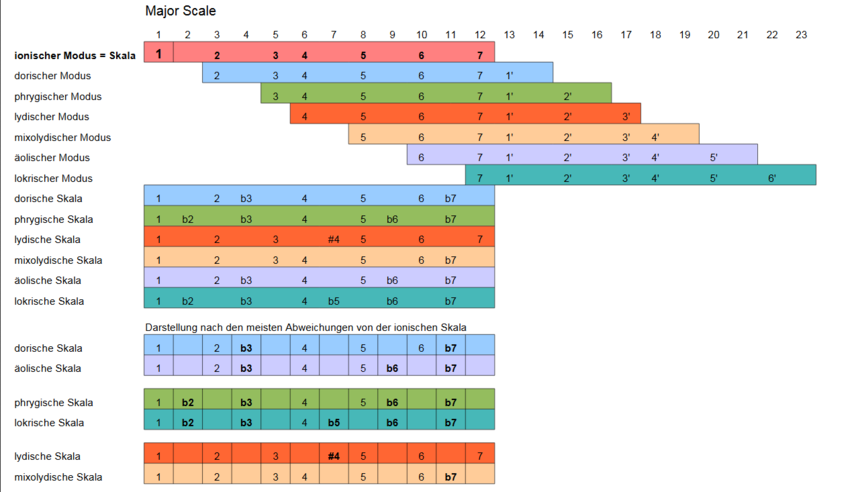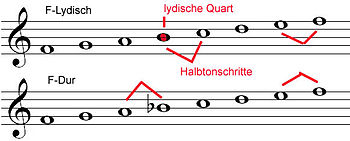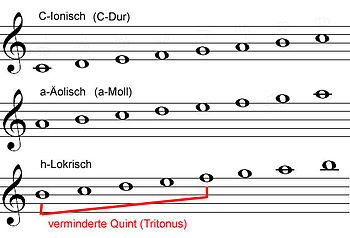Modal scales
| The modes |
|---|
|
Doric Hypodorisch Phrygian Hypophrygian Lydian Hypolydisch mixolydian Hypomixolydisch Aeolian Hypoäolisch Ionic Hypoionisch Locrian |
| See also |
|
Church key Modal scales |
Modal scales , also modal scales or modes for short (singular mode , from Latin mode , "measure", "unit", "rule", "regulation", "type", "manner", "melody", "tone") are
- In the narrower sense, scales that take over the names and tone stock of the old modes (church modes , church tones), but without taking into account the other characteristics of church tones that are important in early music ( ambitus , finalis , repercussa , distinction between authentic and plagal ). The church scales are also referred to below as church scales.
- in a broader sense also (e.g. in modal jazz ) “exotic” scales.
Derivation of the church scales from a major scale
The church tonal modes can be interpreted as different excerpts from the tone stock of any major scale, whereby the relationships are particularly simple (without a sign) in C major .
The Ionic scale is identical to the major scale, the Aeolian to the natural minor scale.
The modal scales can be transposed to any level of the chromatic scale . In order to be able to determine the sign of a certain transposition, it is useful to note the level of the associated major scale at which the modes are established.
For example, if you know that Doric “stands” on the second level of the assigned major scale, you can immediately see that E-Dorian has the same accidentals as D major or F sharp Doric has the same accidentals as E major . Lydian is on the fourth level of a major scale, so A-flat Lydian, for example, has the same accidentals as E flat major .
An alternative method for determining the sign results from the following chapter.
Special features of the church scales
The church scales can each one of Tongeschlechter major or minor assign. They are very similar to either a major or a minor scale and differ from it only in a characteristic pitch.
In the following, the church scales are compared with the similar major / minor scales. The notation is chosen so that no signs are required. First, the scales that go back to the medieval system of church tones are considered.
Minor gender scales
Doric
The Doric scale differs from the natural minor scale in that it has a raised 6th degree, the Doric sixth .
Phrygian
The Phrygian scale differs from the natural minor scale through a lowered 2nd degree, the Phrygian second .
Major gender scales
Lydian
The Lydian scale differs from a major scale in that it has an elevated 4th degree, the Lydian fourth .
Mixolydian
The mixolydian scale is different from a major scale by a lowered seventh stage mixolydian Sept .
Completion of the system (ionic, aeolian, locric)
Today's major and minor emerged from the Ionian and Aeolian modes added in the 16th century . The Ionic scale is therefore identical to the major scale, the Aeolian scale to the natural minor scale.
When Locrian mode there is not a characteristic distinguishing interval to major or minor. To turn a minor scale into a locrian, one has to lower two levels, namely the second and fifth.
There was never a Locrian mode in the system of church tones. The name comes from the music theory of ancient Greece, where it played a rather peripheral role that has never been fully clarified. It was only recently that a new (“Locrian”) mode was invented under the old name in order to complete the system for practical purposes. The locrian scale differs from the others in that a diminished fifth ( tritone ) lies above the fundamental instead of the pure one , which is why it was previously considered unusable. In jazz it nevertheless enjoys a certain popularity as an improvisation scale.
Pictorial representation of all church scales with audio examples
The following graphics illustrate the seven church scales. ( Explanation of the scheme )
 |
 |
 |
 |
 |
 |
 |
As part of his television series Young People's Concerts with the New York Philharmonic Orchestra , Leonard Bernstein explained the system of church modes in November 1966 in the episode "What is a Mode?"
Terminology scale and mode in the context of the church modes
A scale shows the position and spacing of the seven tones in Arabic numerals and always begins with number 1. If the scale deviates from the ionic scale, it is altered and the respective position is marked with b or #.
A mode represents a different view of the tones of the scale, with the mode name describing the respective level at which the scale should begin.

Exotic scales and systems (link list)
“Exotic” is understood here to mean everything that deviates from the major-minor system.
- Pentatonic scale
- Whole tone scale
- Phrygian dominant scale
- Arabic maqamat and Turkish maqamlar
- Gypsy scales
- Mi- Shebeach scale
- altered scale
- enigmatic ladder
- diminished scale
- the early Greek aulos modes
- Ragas of Indian music
- Dastgah system of Persian music
- the twelve Lü of Chinese music
- Slendro and Pélog of gamelan music on the Indonesian islands of Java and Bali
- Blue scale (see also Blue Notes )
- Shepard scale
- Japanese scales
See also
Individual evidence
- ↑ Young People's Concerts , episode What is a Mode? , 1966 (clip on YouTube ), accessed on August 26, 2018.





